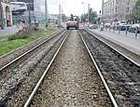












































 Scientists want to suppress vibration and protect city monuments
Scientists want to suppress vibration and protect city monumentsTo design a material that will allow suppressing vibrations generated by trains or city trams, so that they do not harm monuments - this is the task of waiting Bartłomiej Dyniewicz from the Institute of Fundamental Technological Research PAS.